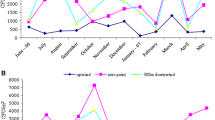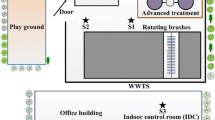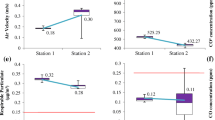Abstract
The main objective of this work was to quantify and characterize the major indoor air contaminants present in different stages of a municipal WWTP, including microorganisms (bacteria and fungi), carbon dioxide, carbon monoxide, hydrogen sulfide ammonia, formaldehyde, and volatile organic compounds (VOCs). In general, the total bacteria concentration was found to vary from 60 to >52,560 colony-forming units (CFU)/m3, and the total fungi concentration ranged from 369 to 14,068 CFU/m3. Generally, Gram-positive bacteria were observed in higher number than Gram-negative bacteria. CO2 concentration ranged from 251 to 9,710 ppm, and CO concentration was either not detected or presented a level of 1 ppm. H2S concentration ranged from 0.1 to 6.0 ppm. NH3 concentration was <2 ppm in most samples. Formaldehyde was <0.01 ppm at all sampling sites. The total VOC concentration ranged from 36 to 1,724 μg/m3. Among the VOCs, toluene presented the highest concentration. Results point to indoor/outdoor ratios higher than one. In general, the highest levels of airborne contaminants were detected at the primary treatment (SEDIPAC 3D), secondary sedimentation, and sludge dehydration. At most sampling sites, the concentrations of airborne contaminants were below the occupational exposure limits (OELs) for all the campaigns. However, a few contaminants were above OELs in some sampling sites.




Similar content being viewed by others
References
Canela, M. C., & Jardim, W. F. (2008). Identification and photocatalytic destruction of malodorous compounds in sewage. Environmental Technology, 29(6), 673–679.
Cyprowski, M., Buczy ska, A., & Szadkowska-Sta czyk, I. (2006). Exposure assessment to bioaerosols among sewer workers. Medycyna Pracy, 57(6), 525.
Dincer, F., & Muezzinoglu, A. (2007). Odor determination at wastewater collection systems: Olfactometry versus H2S analyses. CLEAN–Soil, Air, Water, 35(6), 565–570.
Dincer, F., & Muezzinoglu, A. (2008). Odor-causing volatile organic compounds in wastewater treatment plant units and sludge management areas. Journal of Environmental Science and Health Part a-Toxic/Hazardous Substances & Environmental Engineering, 43(13), 1569–1574.
DR (2007). Decreto-Lei 305/2007 - Diário da República, 1ª série, n.º163 de 24 de Agosto de 2007. Ministério do Trabalho e da Solidariedade social.
EASHW. (2007). Expert forecast on emerging biological risks related to occupational safety and health. Belgium: European Agency for Safety and Health at Work–European Union.
EASHW (2009). Expert forecast on emerging chemical risks related to occupational safety and health Belgium: European Agency for Safety and Health at Work–European Union
EC (1998). Directive 98/24/EC of 7 April 1998 on the protection of the health and safety of workers from the risks related to chemical agents at work. Official Journal of the European Communities L131.
EC (2000a). Directive 2000/39/EC of 8 June 2000 establishing a first list of indicative occupational exposure limit values on the protection of the health and safety of workers from the risks related to chemical agents at work. Official Journal of the European Communities L142.
EC (2000b). Directive 2000/54/EC of the European Parliament and of the Council of 18 September 2000 on the protection of workers from risks related to exposure to biological agents at work. Official Journal of the European Communities L 262.
EC (2006). Directive 2006/15/EC of 7 February 2006 establishing a second list of indicative occupational exposure limit values on the protection of the health and safety of workers from the risks related to chemical agents at work. Official Journal of the European Union L38.
EU (2009). Directive 2009/161/EU of the 17 December 2009 establishing a third list of indicative occupational exposure limit values on the protection of the health and safety of workers from the risks related to chemical agents at work. Official Journal of the European Union. L 338.
Gangamma, S., Patil, R. S., & Mukherji, S. (2011). Characterization and proinflammatory response of airborne biological particles from wastewater treatment plants. Environmental Science and Technology, 45(8), 3282–3287. doi:10.1021/es103652z.
Gerardi, M. H., & Zimmerman, M. C. (2005). Wastewater pathogens. New Jersey: Wiley.
Hamoda, M. F. (2006). Air pollutants emissions from waste treatment and disposal facilities. Journal of Environmental Science and Health Part a-Toxic/Hazardous Substances & Environmental Engineering, 41(1), 77–85.
Heinonen-Tanski, H., Reponen, T., & Koivunen, J. (2009). Airborne enteric coliphages and bacteria in sewage treatment plants. Water Research, 43(9), 2558–2566. doi:10.1016/j.watres.2009.03.006.
ISO (2004). ISO 16000–6 (2004). Determination of volatile organic compounds in indoor and test chamber air by active sampling on Tenax TA sorbent, thermal desorption and gas chromatography using MS or MS/FID.
Kiviranta, H., Tuomainen, A., Reiman, M., Laitinen, S., Nevalainen, A., & Liesivuori, J. (1999). Exposure to airborne microorganisms and volatile organic compounds in different types of waste handling. Annals of Agricultural and Environmental Medicine, 6(1), 39–44.
Korzeniewska, E. (2011). Emission of bacteria and fungi in the air from wastewater treatment plants—a review. Frontiers in bioscience (Scholar edition) [Review].
Lebrero, R., Bouchy, L., Stuetz, R., & Muñoz, R. (2011). Odor assessment and management in wastewater treatment plants: A review. Critical Reviews in Environmental Science and Technology, 41(10), 915–950. doi:10.1080/10643380903300000.
Lee, J. A., Johnson, J. C., Reynolds, S. J., Thorne, P. S., & O’Shaughnessy, P. T. (2006). Indoor and outdoor air quality assessment of four wastewater treatment plants. Journal of Occupational and Environmental Hygiene, 3(1), 36–43. doi:10.1080/1545920500455380.
Li, L., Gao, M., & Liu, J. (2011). Distribution characterization of microbial aerosols emitted from a wastewater treatment plant using the Orbal oxidation ditch process. Process Biochemistry, 46(4), 910–915. doi:10.1016/j.procbio.2010.12.016.
Liu, H.-W., Wu, C.-H., & Lo, J.-G. (2004). Volatile organic compounds in wastewaters during treatment. In: D. Barceló (Ed.), Water Pollution (Vol. 51, pp. 65–93, The Handbook of Environmental Chemistry). New York: Springer.
NP (2007). NP 1796:2007. Occupational health and stafety—Occupational exposure limits to chemical agents.
Oppliger, A., Hilfiker, S., & Duc, T. V. (2005). Influence of seasons and sampling strategy on assessment of bioaerosols in sewage treatment plants in Switzerland. The Annals of Occupational Hygiene, 49(5), 393–400. doi:10.1093/annhyg/meh108.
Paluszak, Z., & Breza-Boruta, B. (2007). Influence of water treatment plant on microbiological composition of air bioaerosol. Polish Journal of Environmental Studies, 16(5), 663–670.
Pascual, L., Pérez-Luz, S., Yáñez, M. A., Santamaría, A., Gibert, K., Salgot, M., et al. (2003). Bioaerosol emission from wastewater treatment plants. Aerobiologia, 19(3), 261–270. doi:10.1023/B:AERO.0000006598.45757.7f.
Prazmo, Z., Krysinska-Traczyk, E., Skorska, C., Sitkowska, J., Cholewa, G., & Dutkiewicz, J. (2003). Exposure to bioaerosols in a municipal sewage treatment plant. Annals of Agricultural and Environmental Medicine, 10(2), 241–248.
Sanchez-Monedero, M. A., Aguilar, M. I., Fenoll, R., & Roig, A. (2008). Effect of the aeration system on the levels of airborne microorganisms generated at wastewater treatment plants. Water Research, 42(14), 3739–3744. doi:10.1016/j.watres.2008.06.028.
Sree, U., Bauer, H., Fuerhacker, M., Ellinger, R., Schmidt, H., & Puxbaum, H. (2000). Hydrocarbons emissions from a municipal wastewater treatment pilot plant in Vienna. Water, Air, and Soil Pollution, 124(1–2), 177–186.
Thorn, J., & Kerekes, E. (2001). Health effects among employees in sewage treatment plants: A literature survey. American Journal of Industrial Medicine, 40(2), 170–179.
Wu, B.-Z., Feng, T.-Z., Sree, U., Chiu, K.-H., & Lo, J.-G. (2006). Sampling and analysis of volatile organics emitted from wastewater treatment plant and drain system of an industrial science park. Analytica Chimica Acta, 576(1), 100–111. doi:10.1016/j.aca.2006.03.057.
Zarra, T., Naddeo, V., & Belgiorno, V. Measurement, management and control of odours in wastewater treatment plants by portable GC-MS. In International Conference on Environmental Odour Monitoring and Control (NOSE2008), 6–8 July, Rome, Italy, 2008 (Vol. 23)
Acknowledgments
Financial support for this work was provided by a FCT project (PTDC/EQU-EQU/100554/2008) and by project PEst-C/EQB/LA0020/2011, financed by FEDER through COMPETE–Programa Operacional Factores de Competitividade and by FCT–Fundação para a Ciência e a Tecnologia for which the authors are thankful. R.A.R. Monteiro and F.V.S. Lopes acknowledge their PhD and post-doc scholarships (SFRH/BD/69323/2010 and SFRH/BPD/73894/2010, respectively), both supported by FCT.
Author information
Authors and Affiliations
Corresponding author
Rights and permissions
About this article
Cite this article
Teixeira, J.V., Miranda, S., Monteiro, R.A.R. et al. Assessment of indoor airborne contamination in a wastewater treatment plant. Environ Monit Assess 185, 59–72 (2013). https://doi.org/10.1007/s10661-012-2533-0
Received:
Accepted:
Published:
Issue Date:
DOI: https://doi.org/10.1007/s10661-012-2533-0




